Implications for sustainable entrepreneurship in Vietnam service sector in the context of 4th industrial revolution
With the booming of technology led by the era of 4th Industrial Revolution, the
establishment of entrepreneurial businesses has been on the rise. This creates
positive effects on job creation, competition as well as innovation and corporate
social responsibility. On the other hand, rapid increases in the number of
businesses without proper control mechanisms may result in damaging impacts
which threaten the development prospect of nations. Sustainable
entrepreneurship, therefore, is the central theme of this paper. Through analyzing
Vietnamese firms’ figures extracted from reliable materials, this paper provides
some insights into the the current status of enterprise development in Vietnam
and makes a discussion on the failures of Vietnamese service firms.
Subsequently, the authors give some implications for sustainable
entrepreneurship in Vietnam service sector, which hopefully can boost firms’
awareness and actions towards sustainability in the years to come.
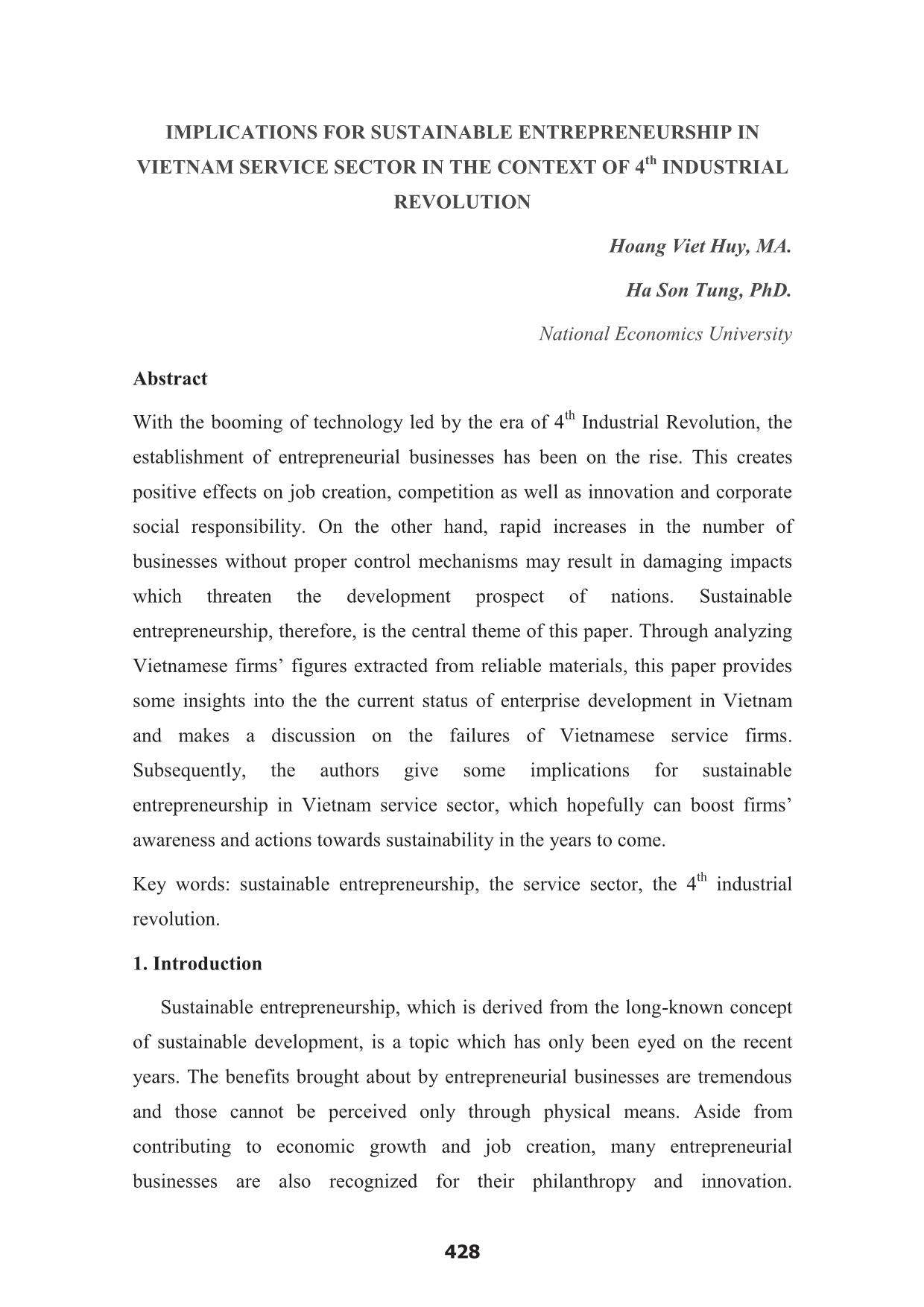
Trang 1
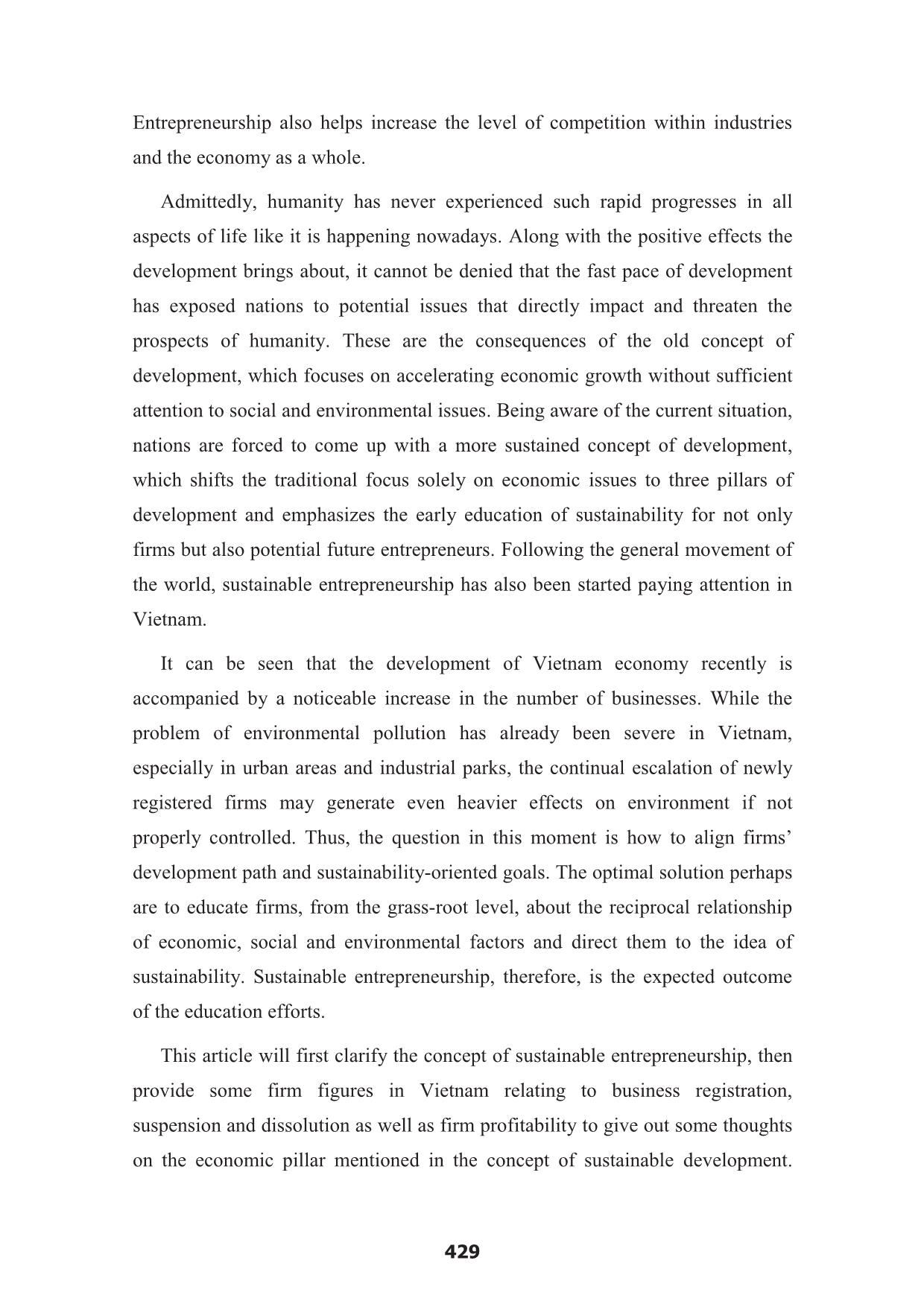
Trang 2
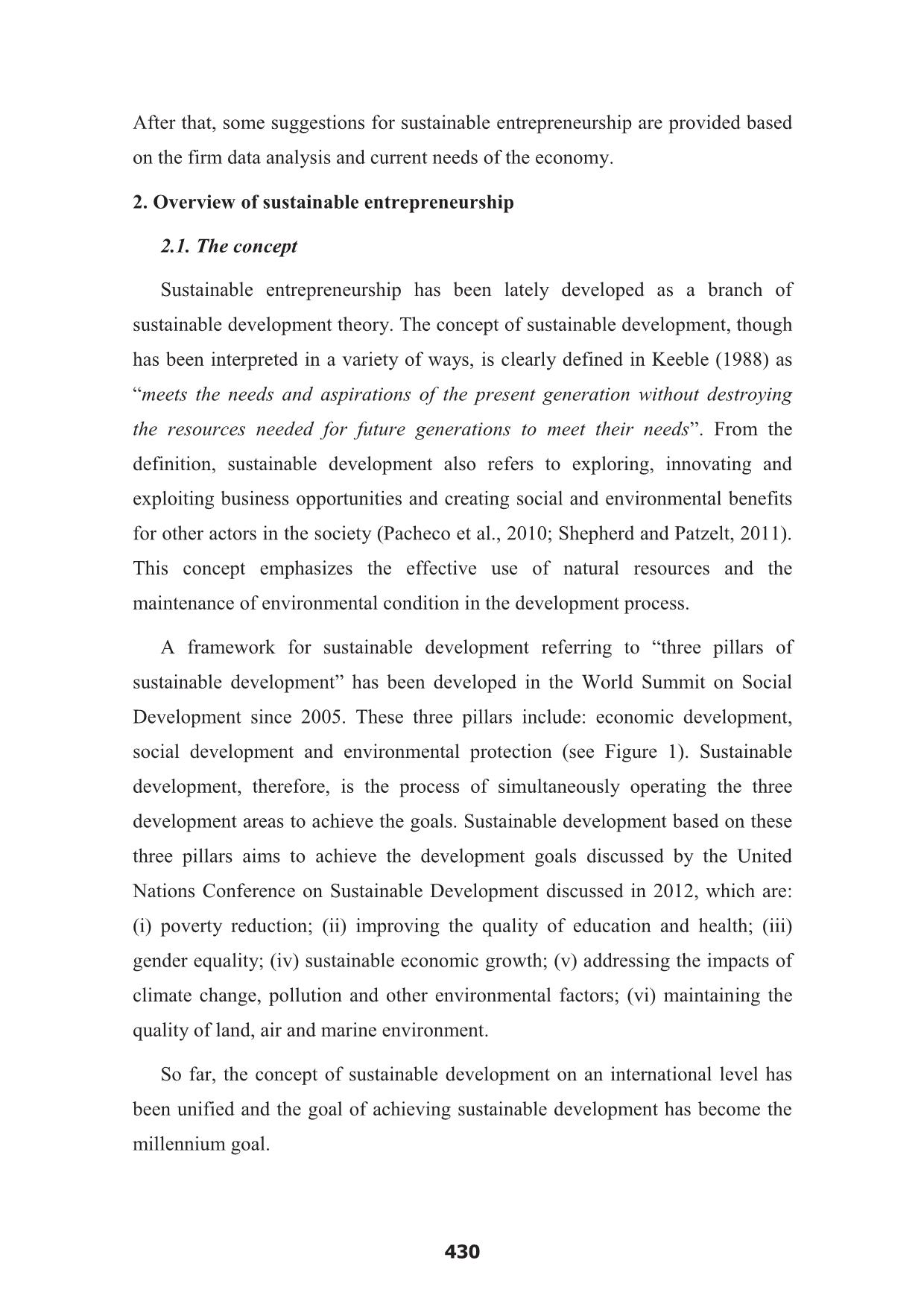
Trang 3
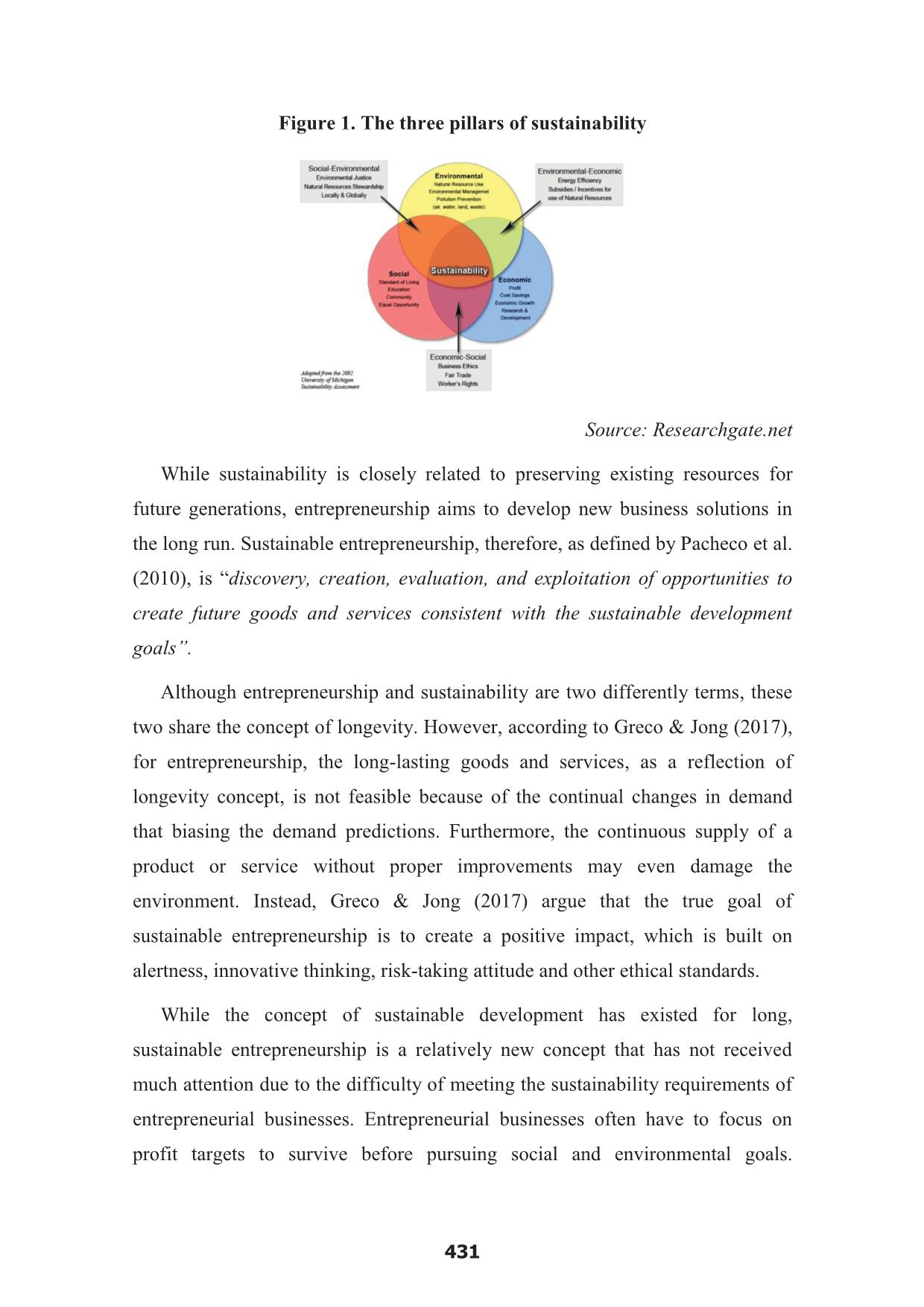
Trang 4
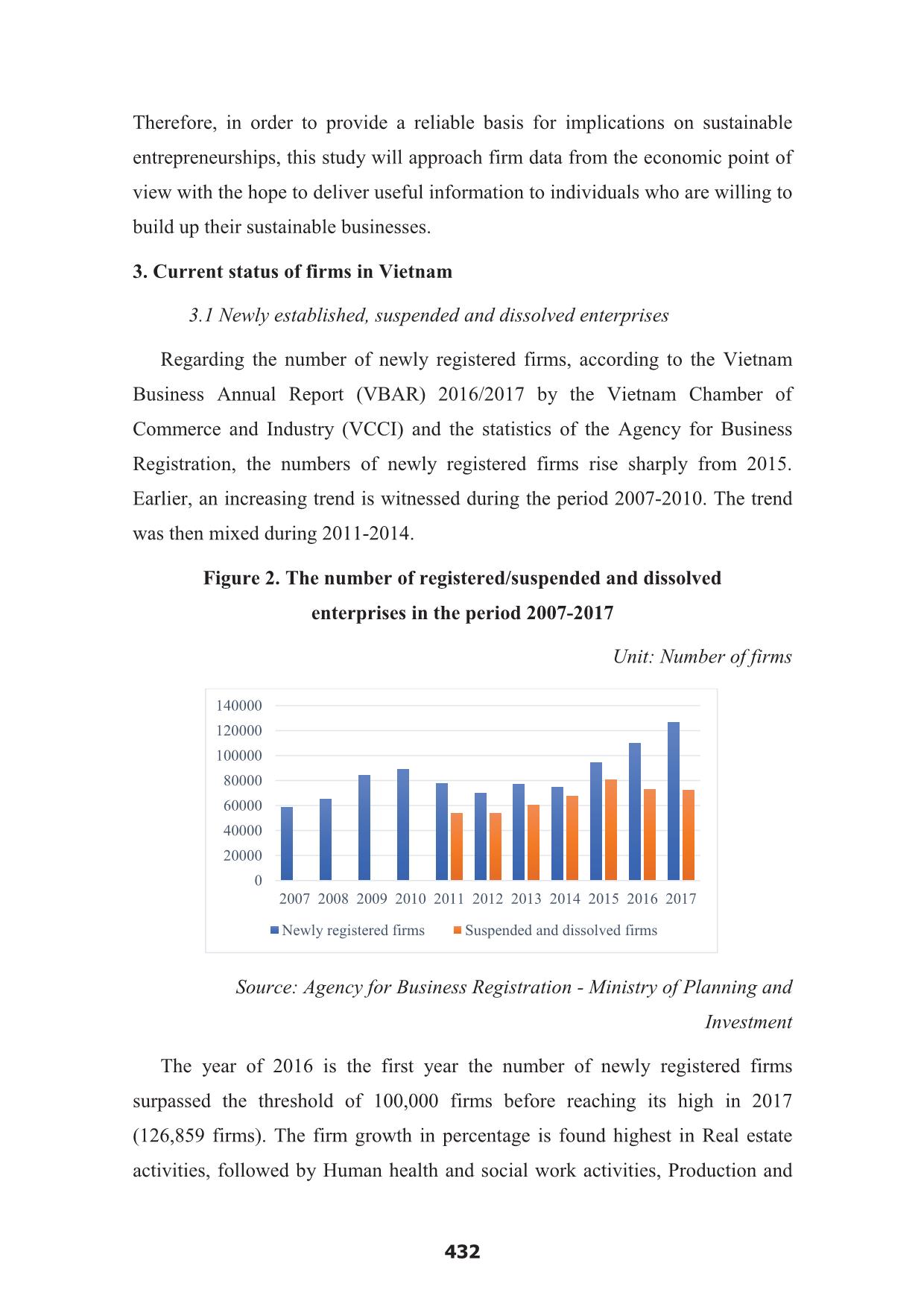
Trang 5
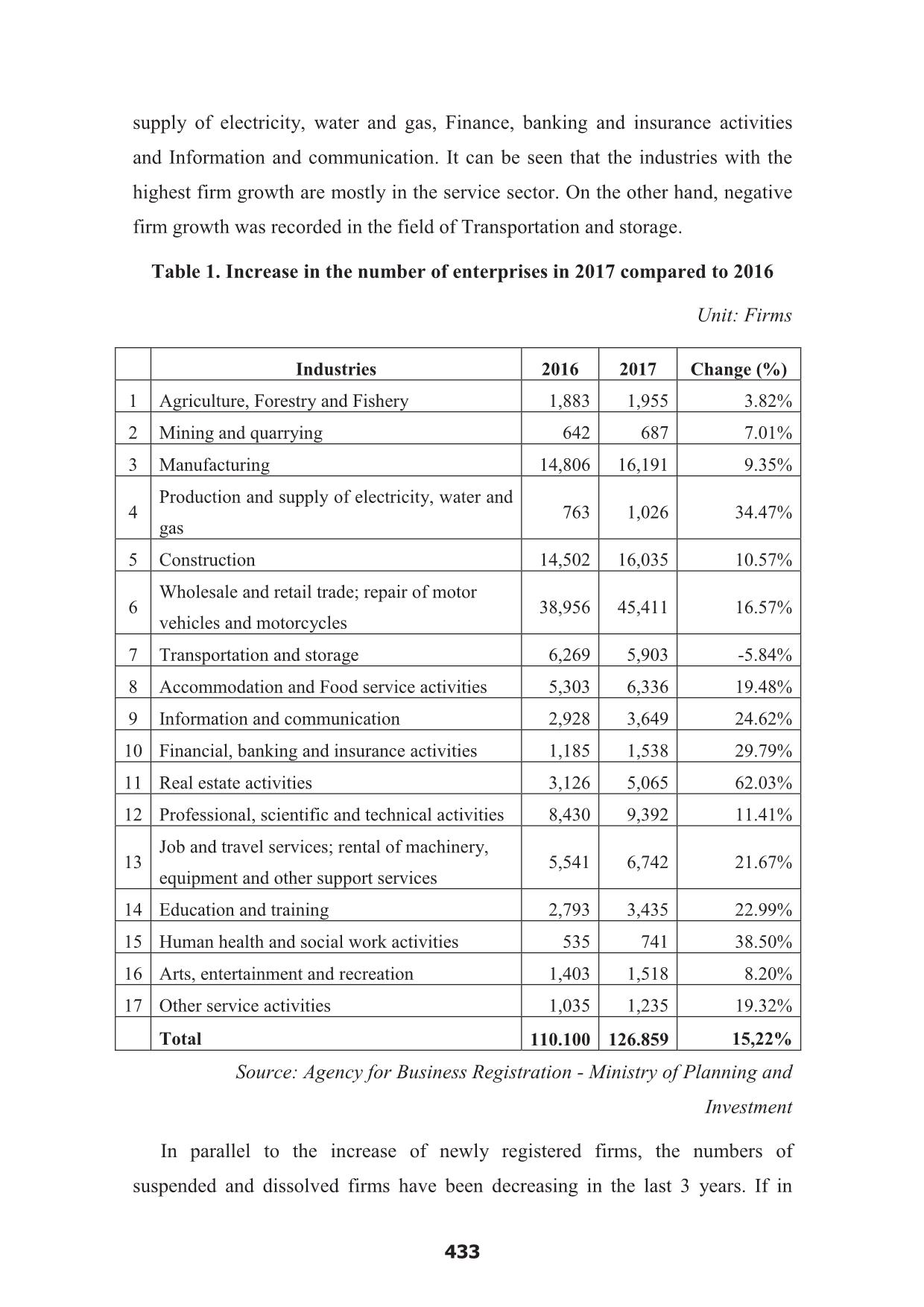
Trang 6
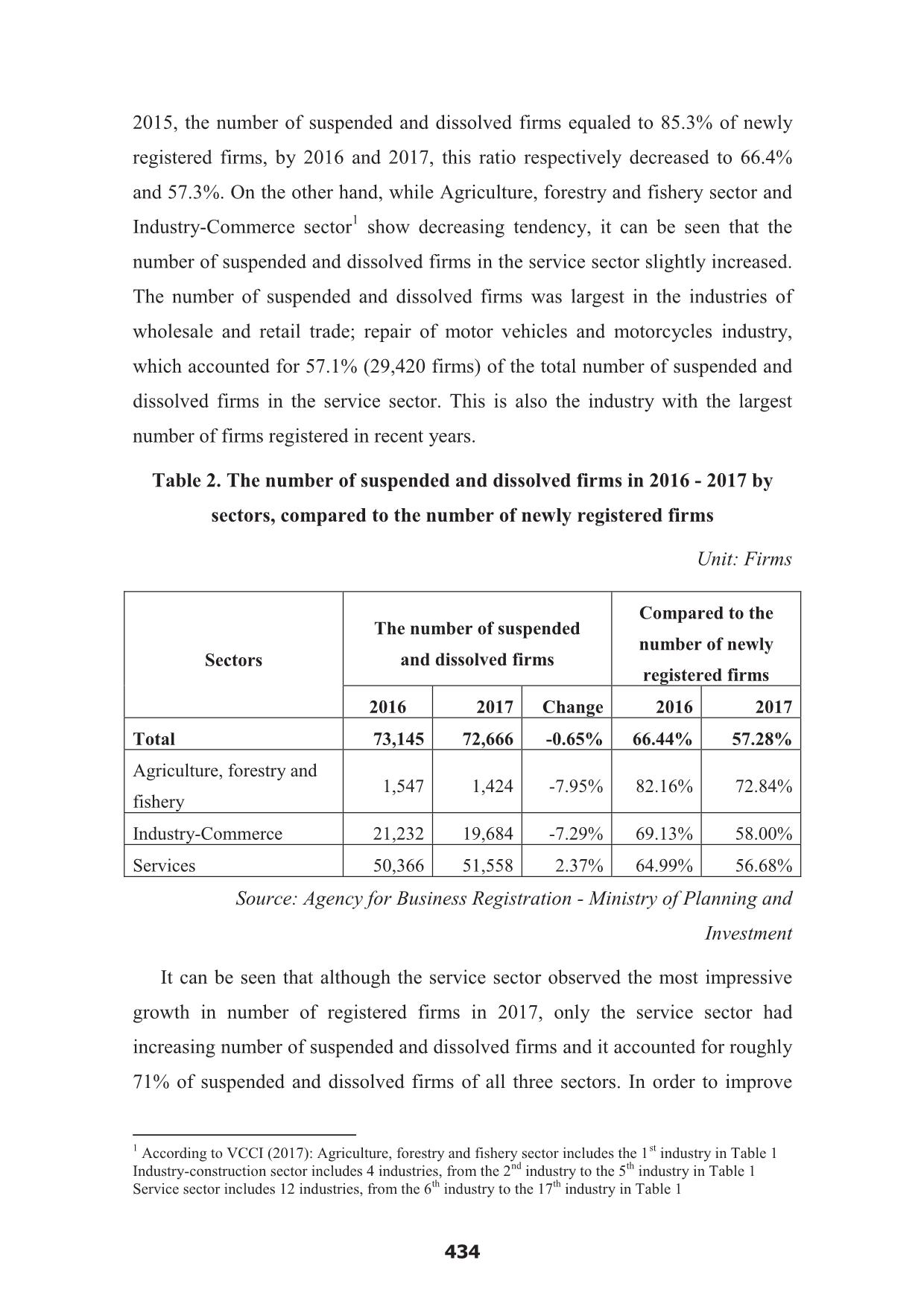
Trang 7
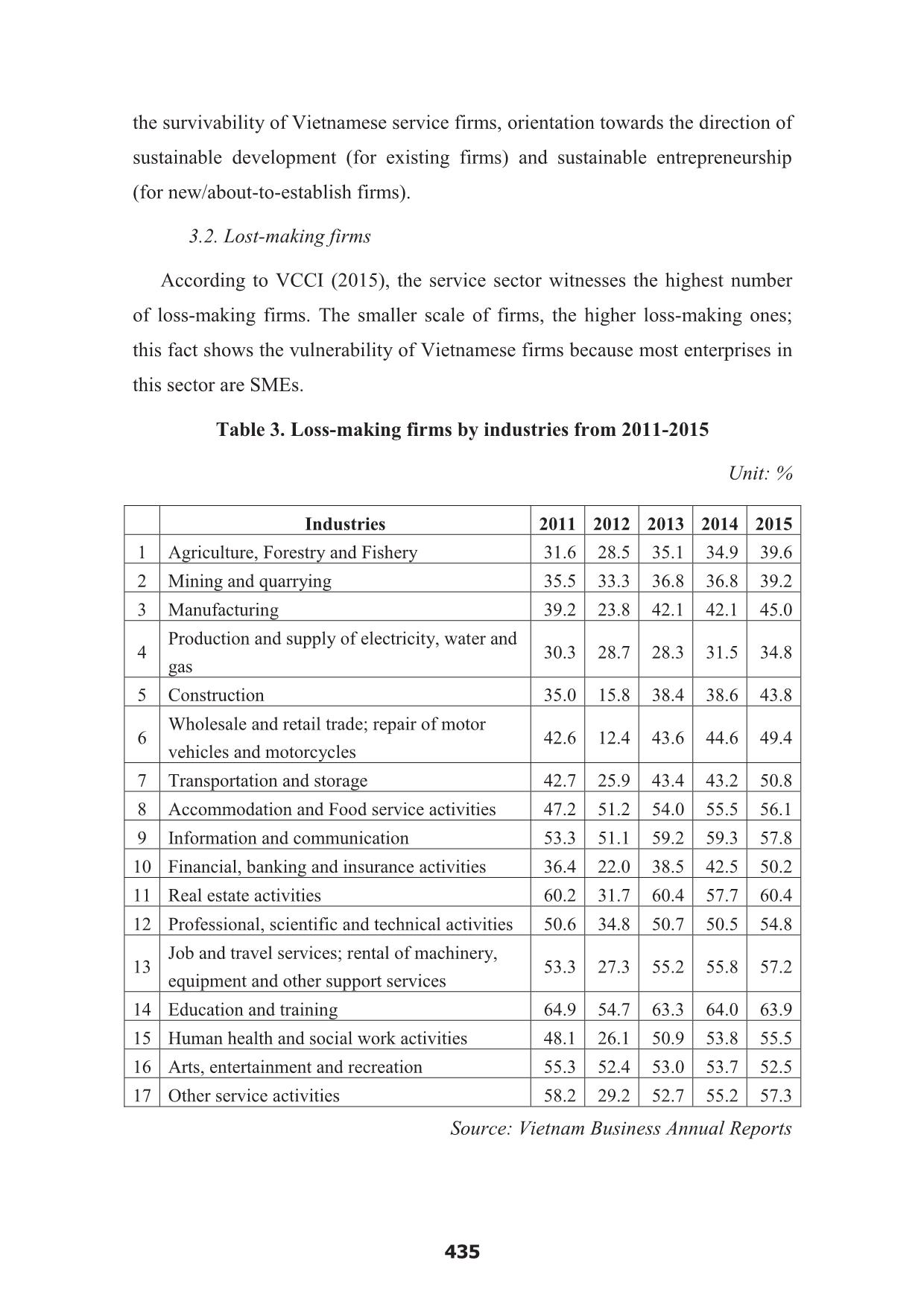
Trang 8
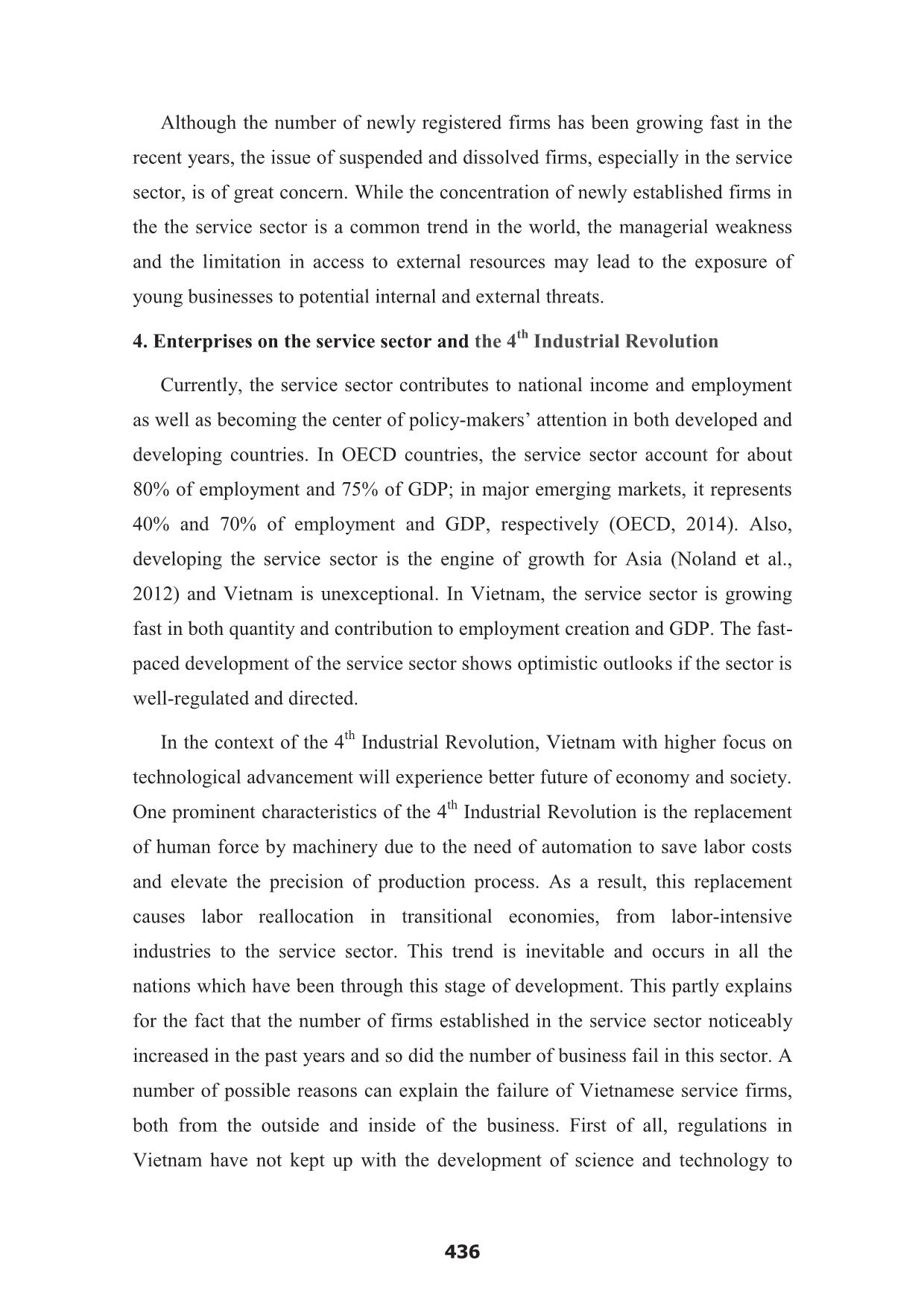
Trang 9
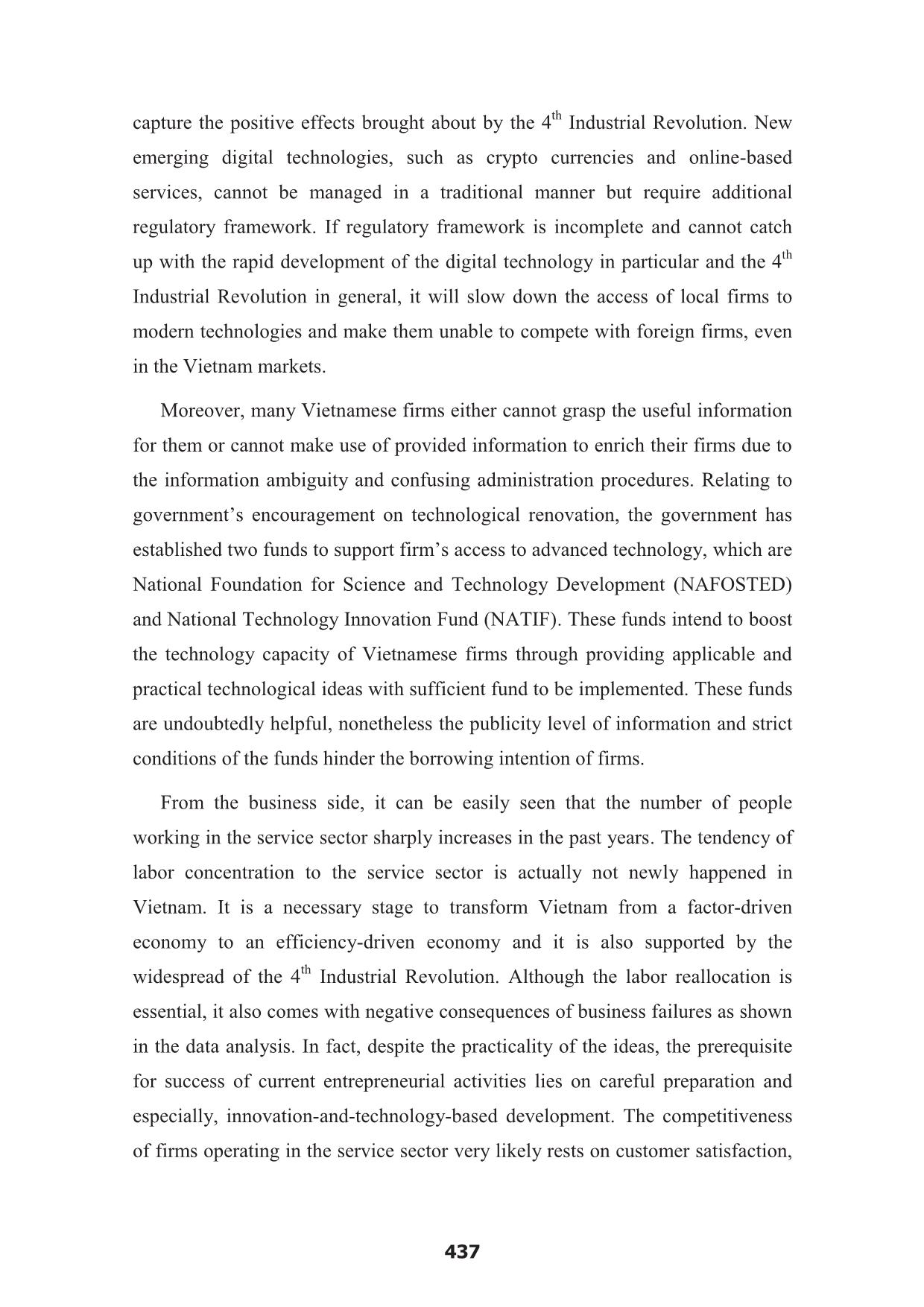
Trang 10
Tải về để xem bản đầy đủ
Tóm tắt nội dung tài liệu: Implications for sustainable entrepreneurship in Vietnam service sector in the context of 4th industrial revolution
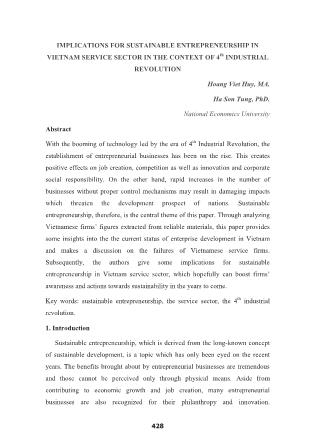
d Industry-Commerce sector1 show decreasing tendency, it can be seen that the number of suspended and dissolved firms in the service sector slightly increased. The number of suspended and dissolved firms was largest in the industries of wholesale and retail trade; repair of motor vehicles and motorcycles industry, which accounted for 57.1% (29,420 firms) of the total number of suspended and dissolved firms in the service sector. This is also the industry with the largest number of firms registered in recent years. Table 2. The number of suspended and dissolved firms in 2016 - 2017 by sectors, compared to the number of newly registered firms Unit: Firms Sectors The number of suspended and dissolved firms Compared to the number of newly registered firms 2016 2017 Change 2016 2017 Total 73,145 72,666 -0.65% 66.44% 57.28% Agriculture, forestry and fishery 1,547 1,424 -7.95% 82.16% 72.84% Industry-Commerce 21,232 19,684 -7.29% 69.13% 58.00% Services 50,366 51,558 2.37% 64.99% 56.68% Source: Agency for Business Registration - Ministry of Planning and Investment It can be seen that although the service sector observed the most impressive growth in number of registered firms in 2017, only the service sector had increasing number of suspended and dissolved firms and it accounted for roughly 71% of suspended and dissolved firms of all three sectors. In order to improve 1 According to VCCI (2017): Agriculture, forestry and fishery sector includes the 1st industry in Table 1 Industry-construction sector includes 4 industries, from the 2nd industry to the 5th industry in Table 1 Service sector includes 12 industries, from the 6th industry to the 17th industry in Table 1 434 the survivability of Vietnamese service firms, orientation towards the direction of sustainable development (for existing firms) and sustainable entrepreneurship (for new/about-to-establish firms). 3.2. Lost-making firms According to VCCI (2015), the service sector witnesses the highest number of loss-making firms. The smaller scale of firms, the higher loss-making ones; this fact shows the vulnerability of Vietnamese firms because most enterprises in this sector are SMEs. Table 3. Loss-making firms by industries from 2011-2015 Unit: % Industries 2011 2012 2013 2014 2015 1 Agriculture, Forestry and Fishery 31.6 28.5 35.1 34.9 39.6 2 Mining and quarrying 35.5 33.3 36.8 36.8 39.2 3 Manufacturing 39.2 23.8 42.1 42.1 45.0 4 Production and supply of electricity, water and gas 30.3 28.7 28.3 31.5 34.8 5 Construction 35.0 15.8 38.4 38.6 43.8 6 Wholesale and retail trade; repair of motor vehicles and motorcycles 42.6 12.4 43.6 44.6 49.4 7 Transportation and storage 42.7 25.9 43.4 43.2 50.8 8 Accommodation and Food service activities 47.2 51.2 54.0 55.5 56.1 9 Information and communication 53.3 51.1 59.2 59.3 57.8 10 Financial, banking and insurance activities 36.4 22.0 38.5 42.5 50.2 11 Real estate activities 60.2 31.7 60.4 57.7 60.4 12 Professional, scientific and technical activities 50.6 34.8 50.7 50.5 54.8 13 Job and travel services; rental of machinery, equipment and other support services 53.3 27.3 55.2 55.8 57.2 14 Education and training 64.9 54.7 63.3 64.0 63.9 15 Human health and social work activities 48.1 26.1 50.9 53.8 55.5 16 Arts, entertainment and recreation 55.3 52.4 53.0 53.7 52.5 17 Other service activities 58.2 29.2 52.7 55.2 57.3 Source: Vietnam Business Annual Reports 435 Although the number of newly registered firms has been growing fast in the recent years, the issue of suspended and dissolved firms, especially in the service sector, is of great concern. While the concentration of newly established firms in the the service sector is a common trend in the world, the managerial weakness and the limitation in access to external resources may lead to the exposure of young businesses to potential internal and external threats. 4. Enterprises on the service sector and the 4th Industrial Revolution Currently, the service sector contributes to national income and employment as well as becoming the center of policy-makers’ attention in both developed and developing countries. In OECD countries, the service sector account for about 80% of employment and 75% of GDP; in major emerging markets, it represents 40% and 70% of employment and GDP, respectively (OECD, 2014). Also, developing the service sector is the engine of growth for Asia (Noland et al., 2012) and Vietnam is unexceptional. In Vietnam, the service sector is growing fast in both quantity and contribution to employment creation and GDP. The fast- paced development of the service sector shows optimistic outlooks if the sector is well-regulated and directed. In the context of the 4th Industrial Revolution, Vietnam with higher focus on technological advancement will experience better future of economy and society. One prominent characteristics of the 4th Industrial Revolution is the replacement of human force by machinery due to the need of automation to save labor costs and elevate the precision of production process. As a result, this replacement causes labor reallocation in transitional economies, from labor-intensive industries to the service sector. This trend is inevitable and occurs in all the nations which have been through this stage of development. This partly explains for the fact that the number of firms established in the service sector noticeably increased in the past years and so did the number of business fail in this sector. A number of possible reasons can explain the failure of Vietnamese service firms, both from the outside and inside of the business. First of all, regulations in Vietnam have not kept up with the development of science and technology to 436 capture the positive effects brought about by the 4th Industrial Revolution. New emerging digital technologies, such as crypto currencies and online-based services, cannot be managed in a traditional manner but require additional regulatory framework. If regulatory framework is incomplete and cannot catch up with the rapid development of the digital technology in particular and the 4th Industrial Revolution in general, it will slow down the access of local firms to modern technologies and make them unable to compete with foreign firms, even in the Vietnam markets. Moreover, many Vietnamese firms either cannot grasp the useful information for them or cannot make use of provided information to enrich their firms due to the information ambiguity and confusing administration procedures. Relating to government’s encouragement on technological renovation, the government has established two funds to support firm’s access to advanced technology, which are National Foundation for Science and Technology Development (NAFOSTED) and National Technology Innovation Fund (NATIF). These funds intend to boost the technology capacity of Vietnamese firms through providing applicable and practical technological ideas with sufficient fund to be implemented. These funds are undoubtedly helpful, nonetheless the publicity level of information and strict conditions of the funds hinder the borrowing intention of firms. From the business side, it can be easily seen that the number of people working in the service sector sharply increases in the past years. The tendency of labor concentration to the service sector is actually not newly happened in Vietnam. It is a necessary stage to transform Vietnam from a factor-driven economy to an efficiency-driven economy and it is also supported by the widespread of the 4th Industrial Revolution. Although the labor reallocation is essential, it also comes with negative consequences of business failures as shown in the data analysis. In fact, despite the practicality of the ideas, the prerequisite for success of current entrepreneurial activities lies on careful preparation and especially, innovation-and-technology-based development. The competitiveness of firms operating in the service sector very likely rests on customer satisfaction, 437 which is hugely influenced by technology and innovation factors during the ongoing 4th Industrial Revolution. To some extent, labor reallocation also affects regional population. The development of service sector may indicate increasing flow of migrants from countryside to urban areas. This movement possibly causes shortage of personnel working in the primary sector (agriculture, forestry and fishery) and secondary sector (industry-construction), which in turn results in the decline in efficiency of these sectors. Therefore, reasonable allocation of resources to remain balanced development of the three sectors is among the keys to achieve sustainable development. Unfortunately, the awareness of the business community about the Industrial Revolution 4.0 is limited. According to Bui (2017), a recent survey conducted with a sample of 2,000 firms of the Hanoi Association of Small and Medium Enterprises revealed that 79% of respondents did not prepare for the 4th Industrial Revolution; 55% of respondents said they were preparing; 19% of businesses had built plans (but not yet implemented) and only 12% of respondents were implementing adaption measures. For businesses which are not interested in the 4th Industrial Revolution, the common reasons are (i) they did not feel the 4th Industrial Revolution would affect their firms and their industries; (ii) they do not understand the nature of the 4th Industrial Revolution; and (iii) there is no need for concern about it. Furthermore, a significant proportion of Vietnamese businesses have not paid much attention to their image, reflecting through the fact that only 49% of firms have their own websites, reported by VECOM (2017). VCCI’s (2015) study on technology management also pointed out low awareness regarding technology development and application of Vietnamese firms: only 34% of firms surveyed had R&D department and only roughly 14% of firms was applying new technology from the leading developed countries. In an era when technology and innovation are gradually being seen as prominent development pillars of businesses, firms need to become more proactive in R&D in order to shape their competitive advantages against competitors in the market. 438 5. Implications for sustainable entrepreneurship in Vietnam’s service sector in the 4th Industrial Revolution In the service sector, the number of newly established firms is huge but the amount of suspended, dissolved and loss-making ones is not small. As mentioned above, there are many reasons underlying this fact. In the light of the 4th Industrial Revolution, some suggestions for sustainable entrepreneurship in the service sector are proposed as follows: Firstly, the awareness of the business community about the 4th Industrial Revolution is limited as shown above. Thus, enhancing the awareness of firms in the service sector on the Industrial Revolution 4.0 must be put in priority. It is needed to understand that this is not just a digital transformation, it's an intelligence transformation. Secondly, equipping appropriate business management skills in the 4th Industrial Revolution is necessarily. Computer processing power has reached its limits, silicon chips are the size of atoms now, and they can’t get any smaller. Automation, digital platforms, and other innovations are changing the fundamental nature of work. This requires businessman appropriate skills to manage businesses. Lastly, Vietnamese entrepreneurial service firms must apply modern technology in doing business. Global development trend shows that entrepreneurial businesses need to be technology-integrated, especially during the 4th Industrial Revolution. An increasing number of businesses is using software tools, such as Enterprise Resource Planning (ERP) and Customer Relationship Management (CRM), to improve management efficiency. More technology-oriented firms may apply a complex system of operations and management tools to run the businesses. The active application of technological advancements from the beginning, nonetheless more expensive, will help entrepreneurs firmly build the foundation for their business. 6. Conclusion 439 The development can be a double-edged sword. If the development is well- planned and managed, it will generate a wide range of benefits in various aspects for a society; inversely, the society may suffer from asynchronous development, which in turn creates unfavorable economic, social and environmental effects. Two major shifts in Vietnam economy are witnessed in this transitional phase, which are the shift from the state-owned business sector to private business sector and the concentration of firms in service sector. Both of these are indispensable tendency of any markets when reaching certain development stages. Using the statistical figures relating to entrepreneurship in the recent years, this paper is a reference for individuals who are having intention to engage in entrepreneurial activities and looking for sustainability approach to the business. 440 References Bui, T. T. Q. (2017). Cơ hội và thách thức của doanh nghiệp trước cuộc cách mạng công nghiệp 4.0. Review of Finance, 2(4/2017). Retrieved May 10th, 2018, thuc-cua-doanh-nghiep-truoc-cuoc-cach-mang-cong-nghiep-40-114346.html Greco, A. and Jong, G. d. (2017). Sustainable entrepreneurship: definitions, themes and research gaps. Working paper series 1706-CSE. University of Groningen: Centre for Sustainable Entrepreneurship. Keeble, B. R. (1988). The Brundtland Report: “One Common Future”. Medicine and War, 4, 17-25. Noland, M., Park, D. and Estrada, G. E. B. (2012). Developing the Service Sector as Engine of Growth for Asia: An Overview, Retrieved June 8th, 2018, https://www.adb.org/sites/default/files/publication/30080/economics-wp320.pdf Pacheco, D. F., Dean, T. J. and Payne, D. S. (2010). Escaping the green prison: Entrepreneurship and the creation of opportunities for sustainable development. Journal of Business Venturing, 25(5), 464-480. Shepherd, D.A. and Patzelt, H. (2011). The new field of sustainable entrepreneurship: studying entrepreneurial action linking “what is to be sustained” with “what is to be developed”. Entrepreneurship Theory and Practice, 35(1), 137-163. VCCI (2015). Vietnam Business Annual Report 2015 - Theme of the year: Business Development Services. Hanoi: Information and Communications Publishing House. VCCI (2017). Vietnam Business Annual Report 2016/2017 - Theme of the year: Corporate Governance. Hanoi: Information and Communications Publishing House. VECOM (2017). Vietnam E-business Index 2017. Hanoi. Retrieved Jun 14th, 2018, 441
File đính kèm:
 implications_for_sustainable_entrepreneurship_in_vietnam_ser.pdf
implications_for_sustainable_entrepreneurship_in_vietnam_ser.pdf

